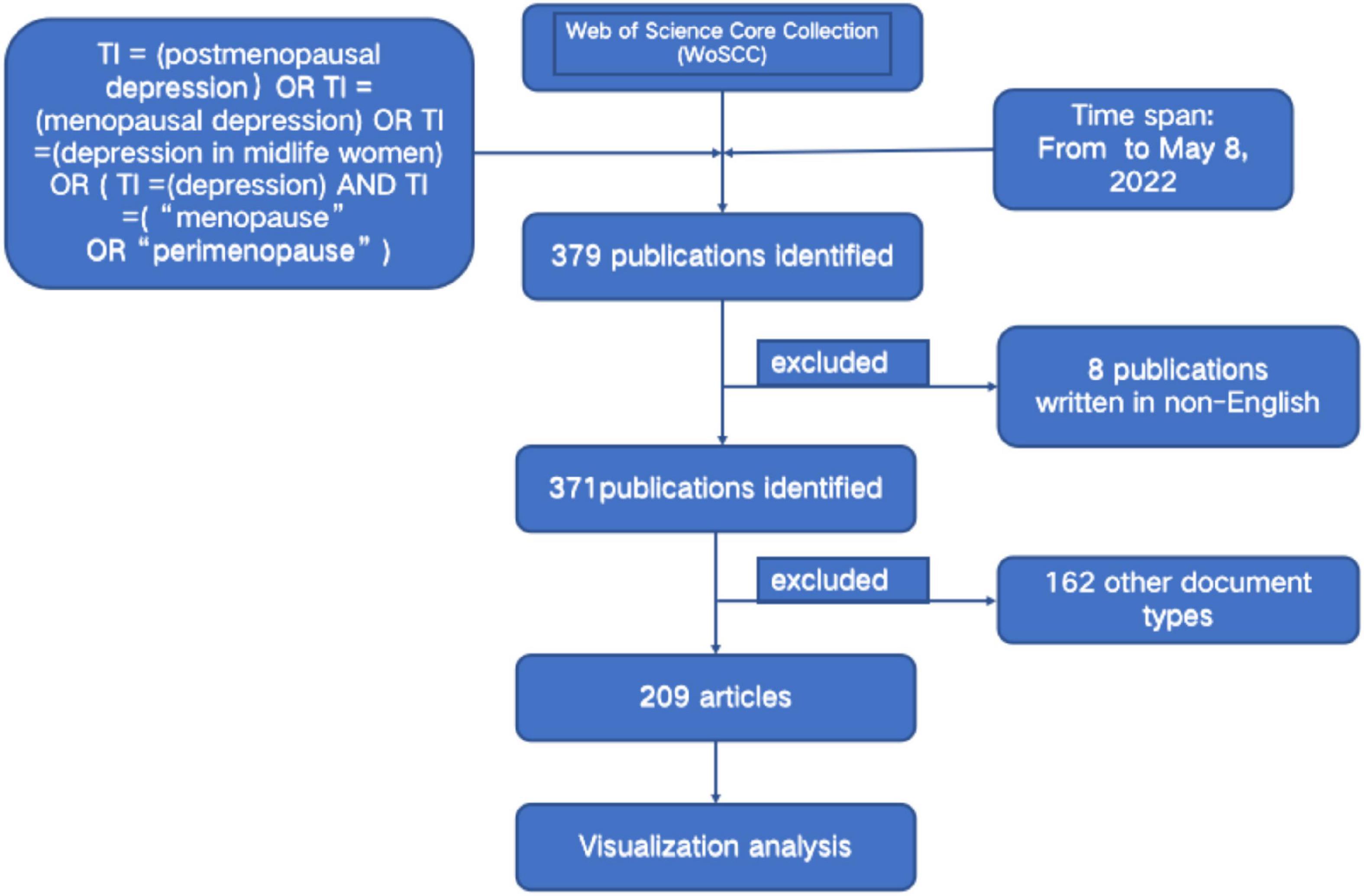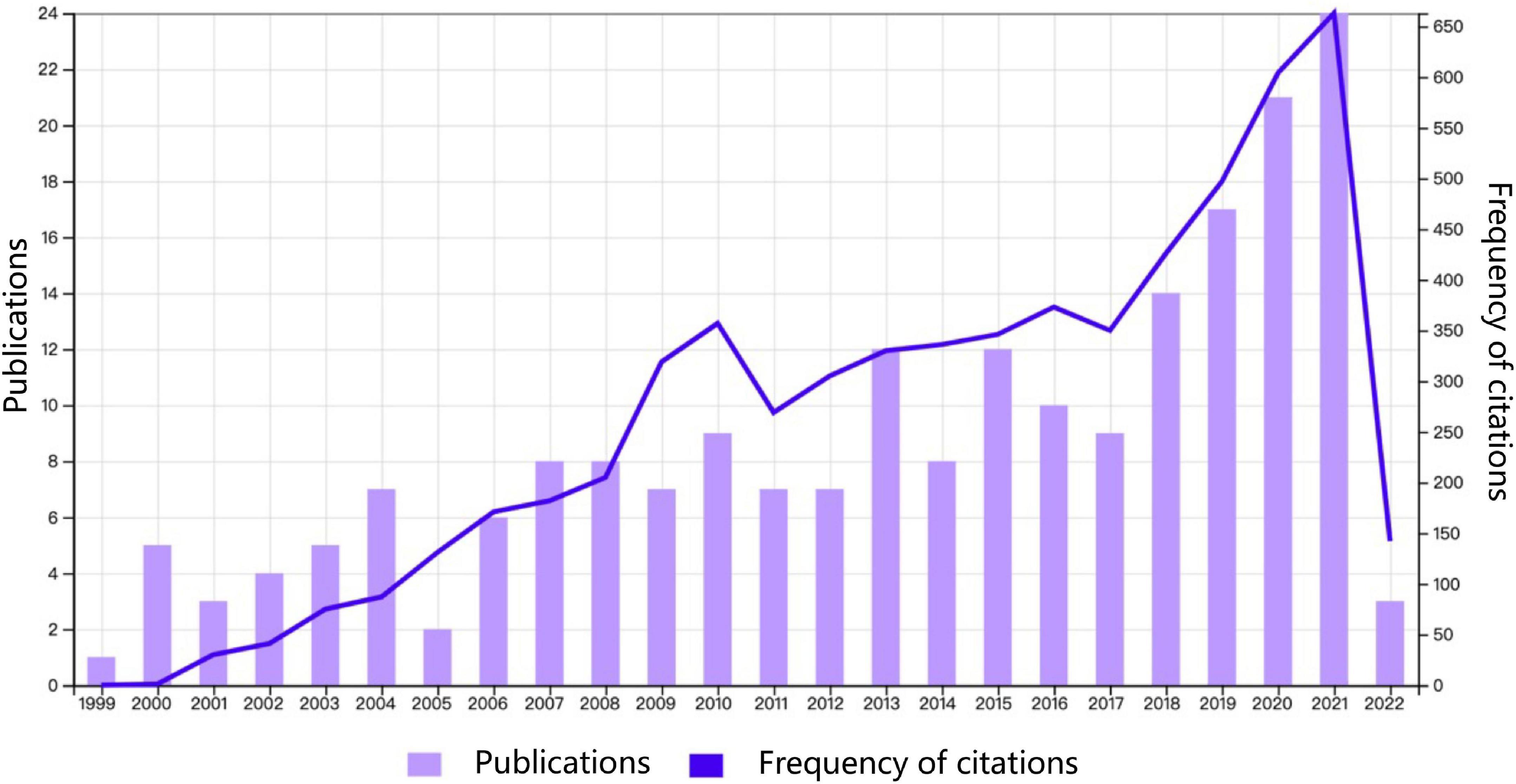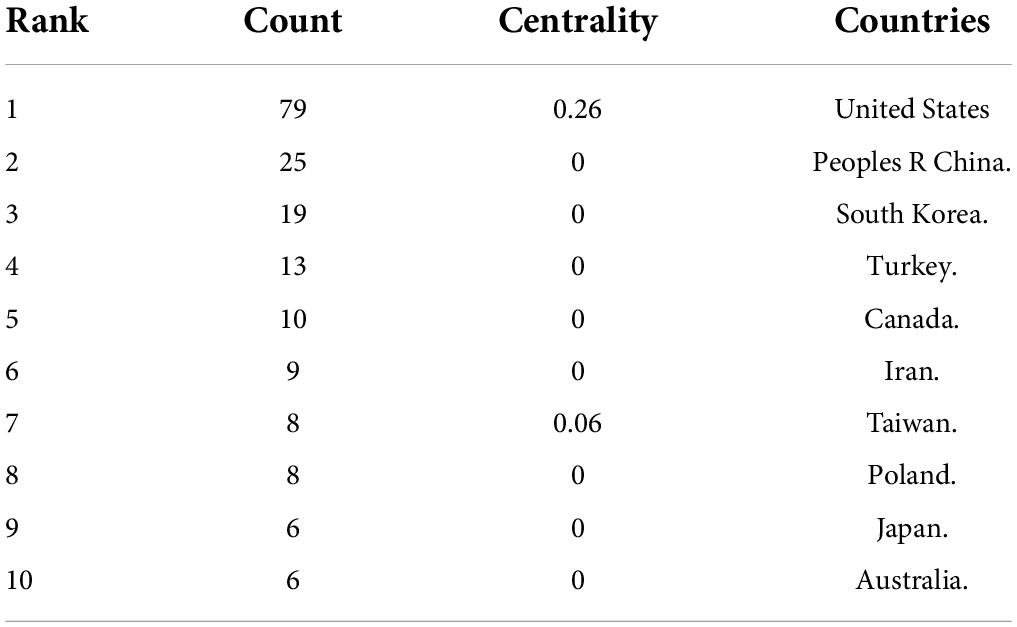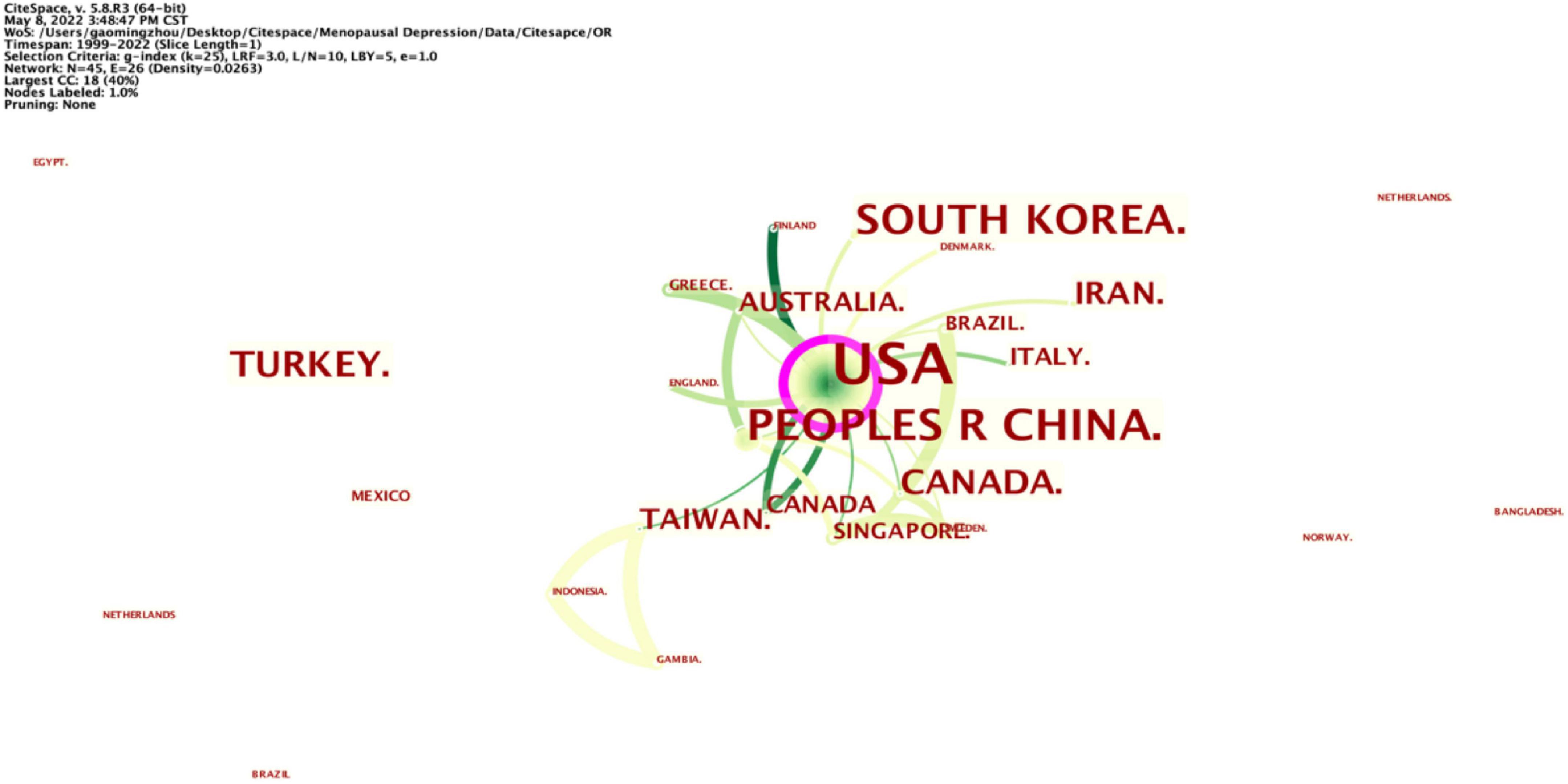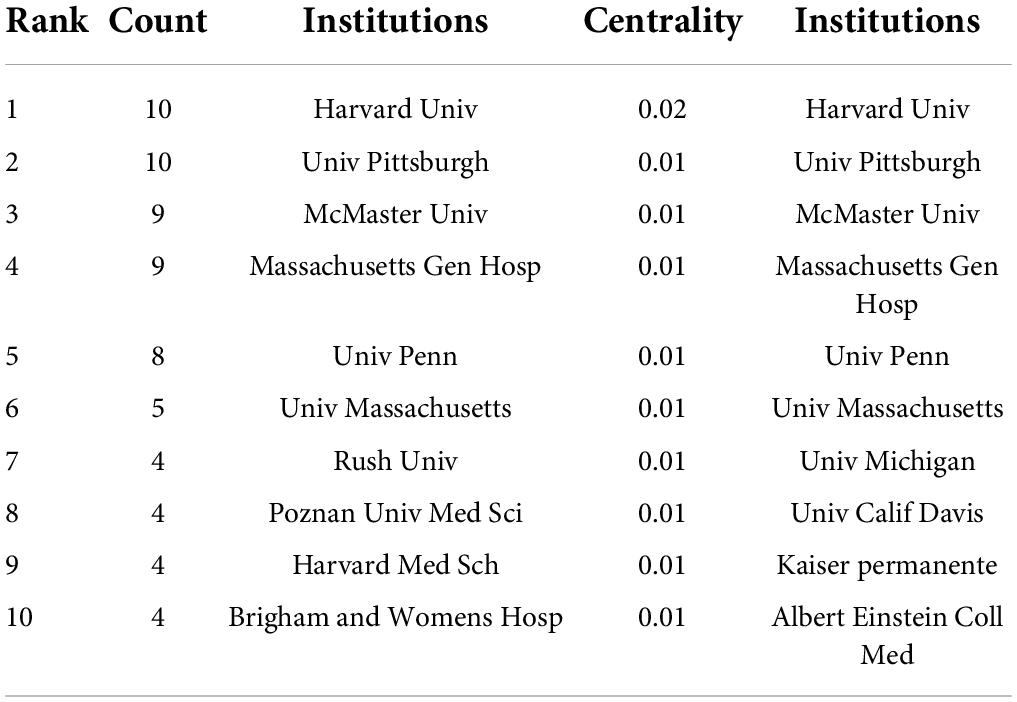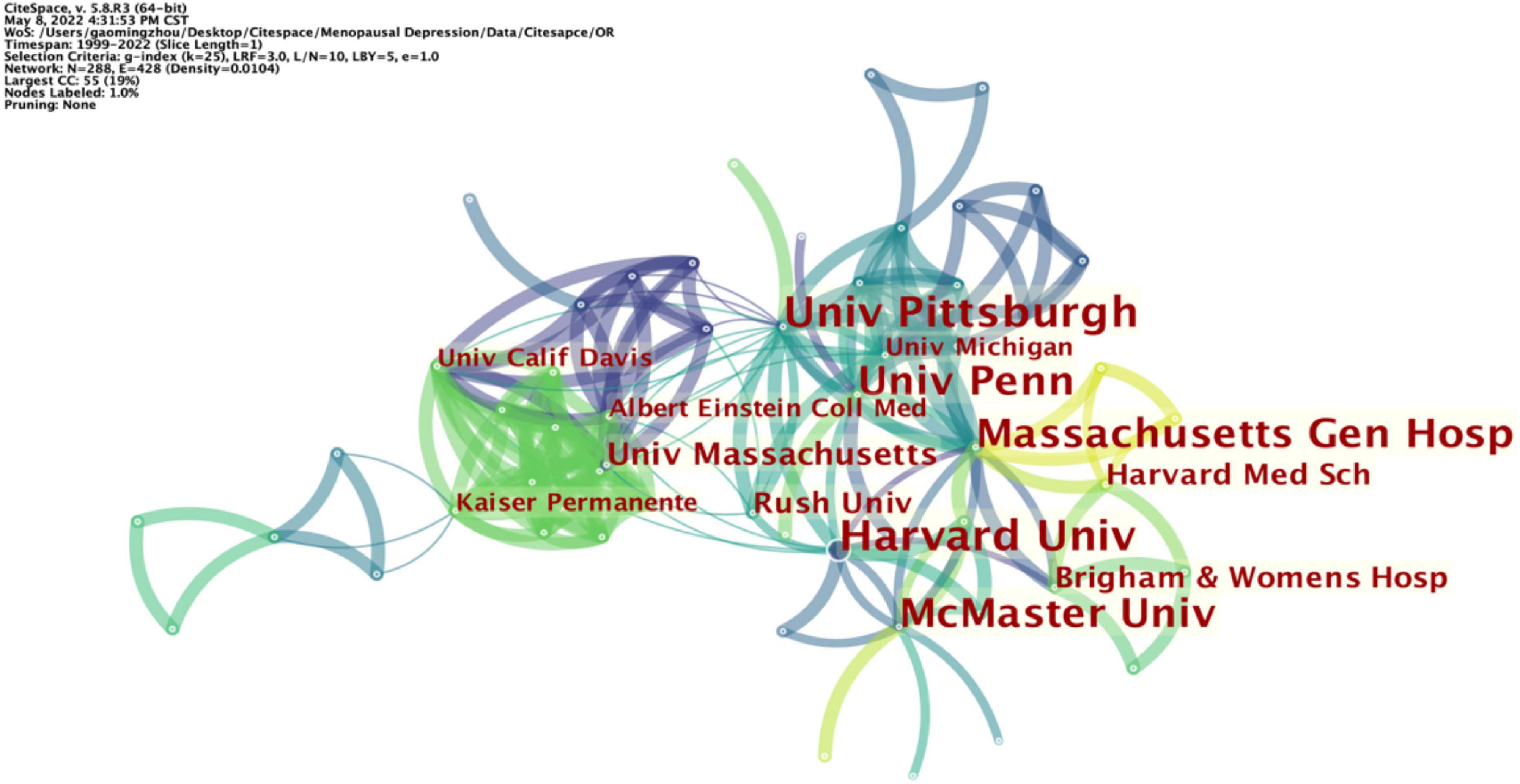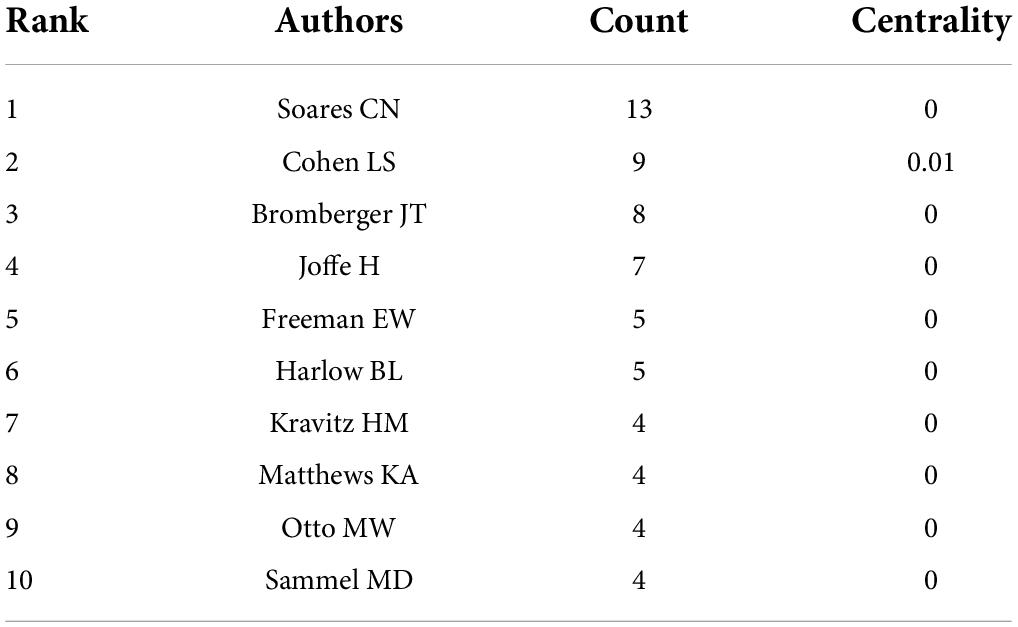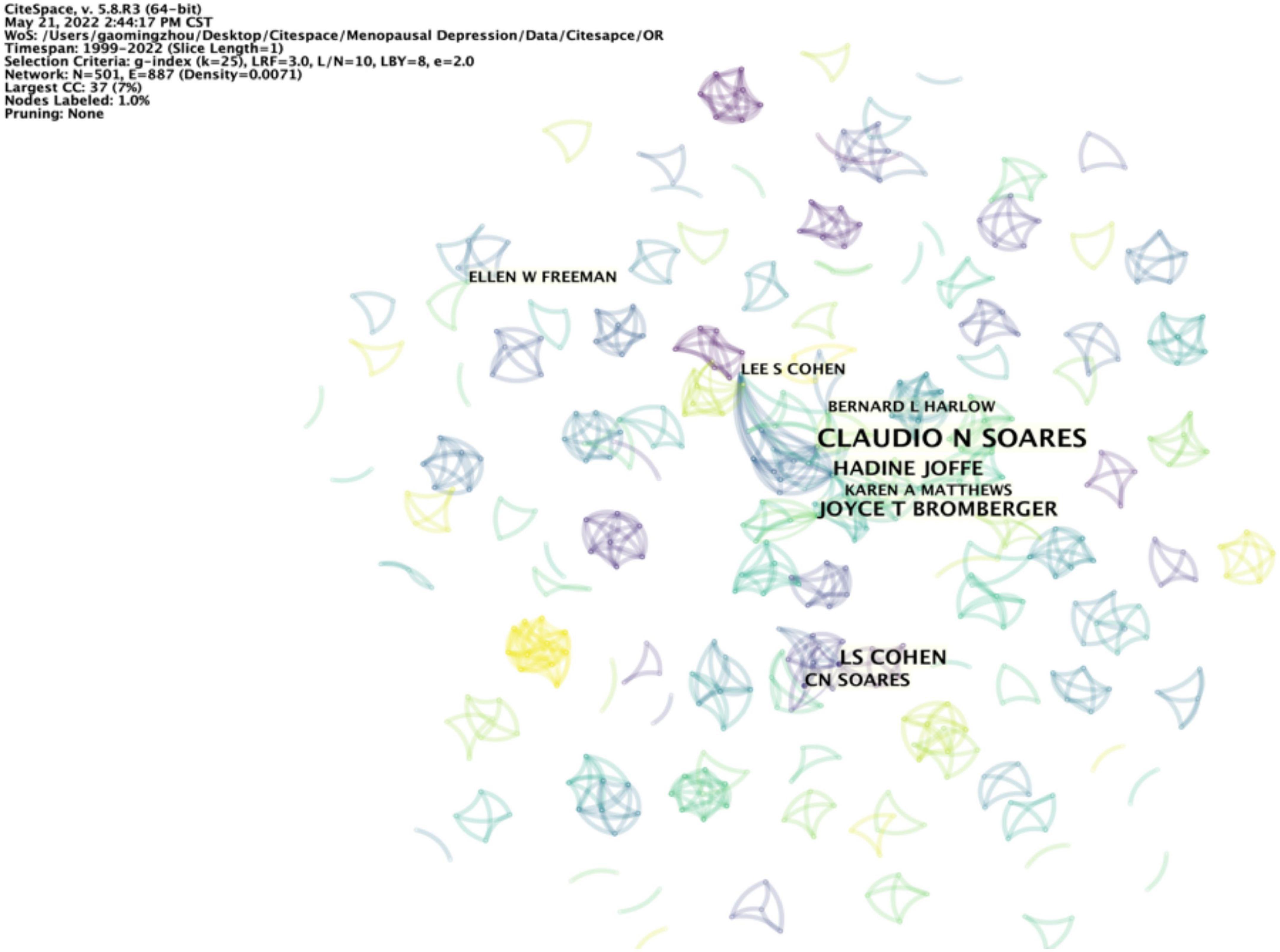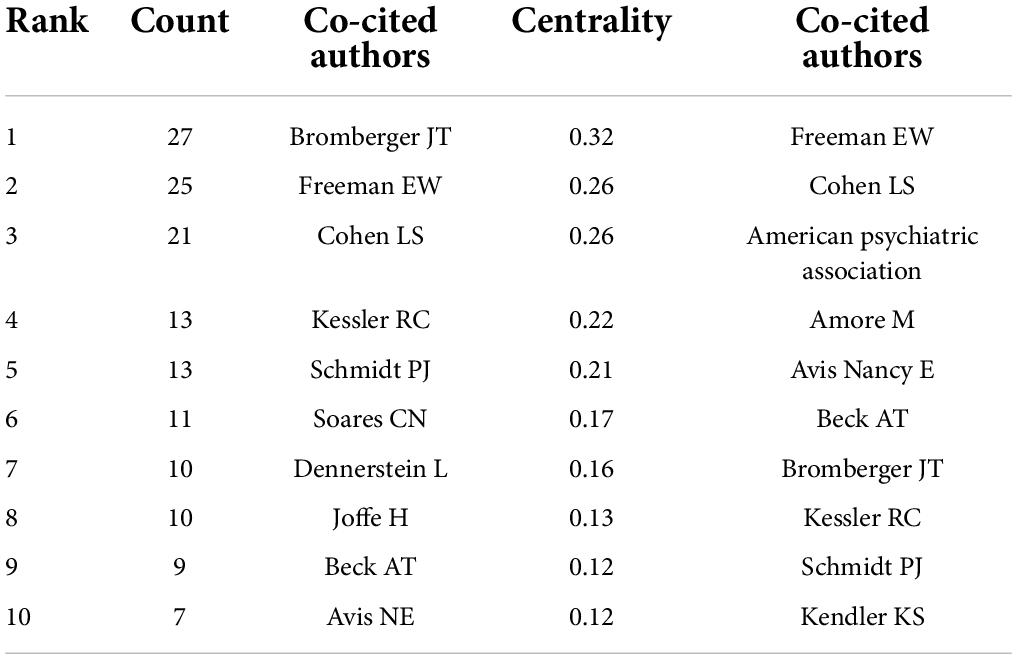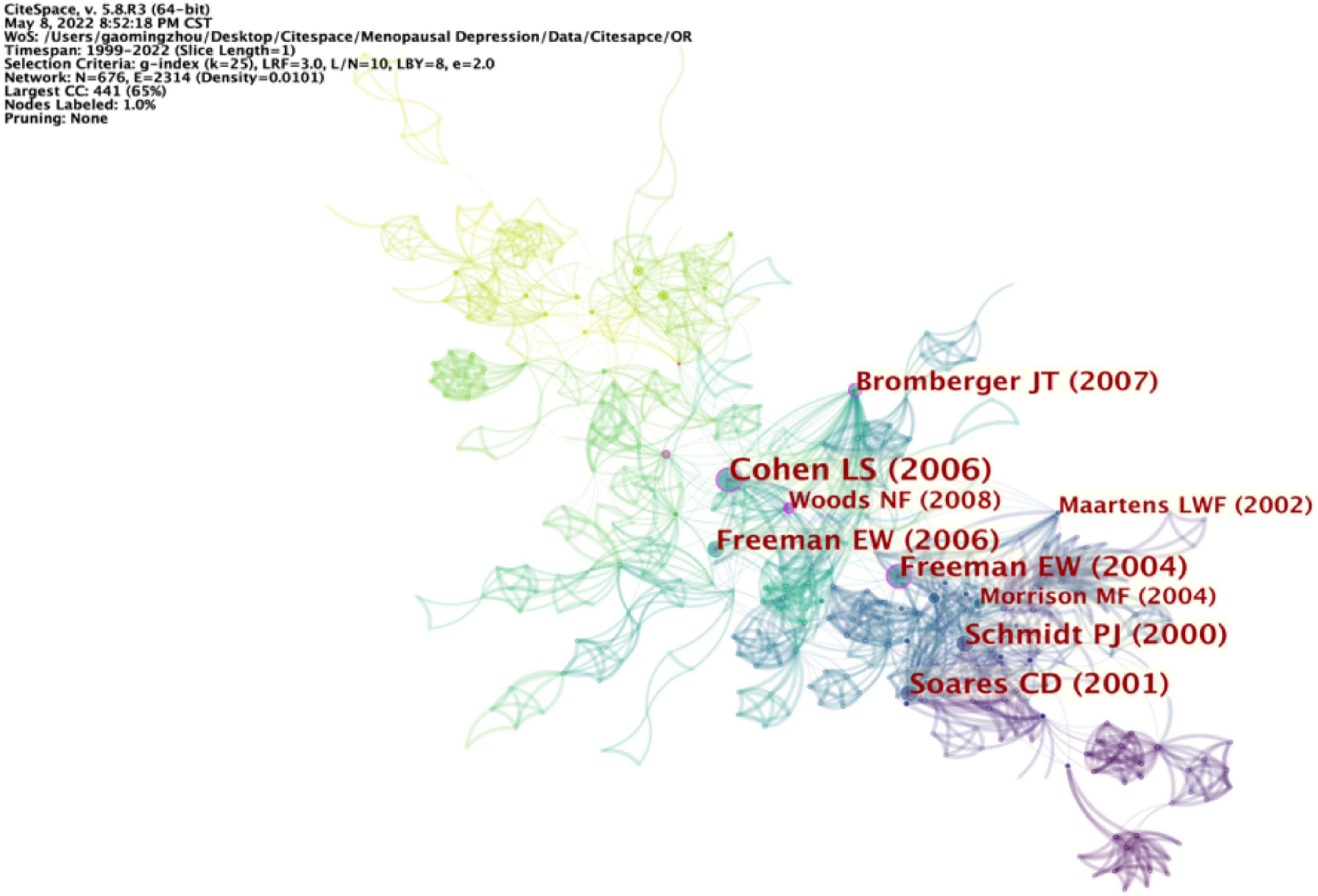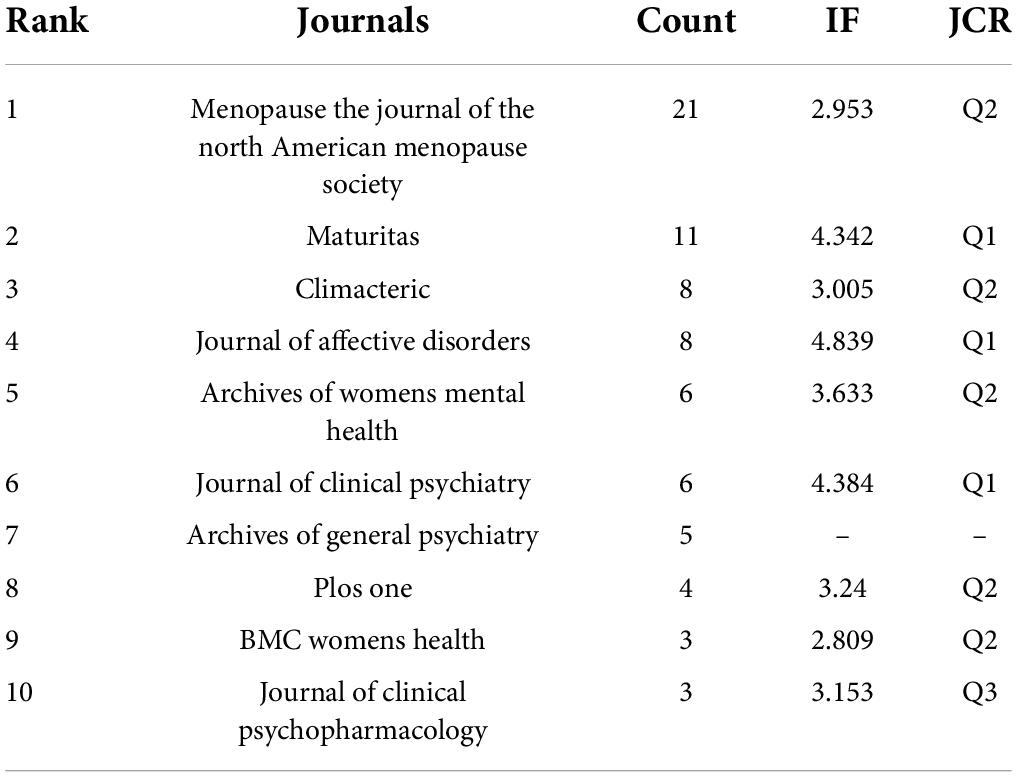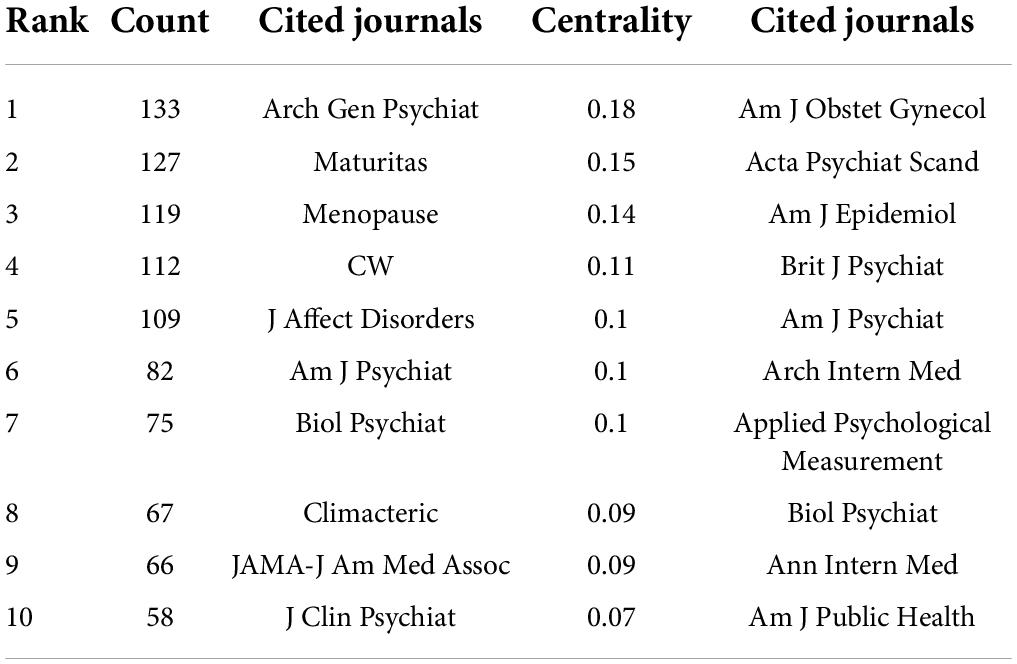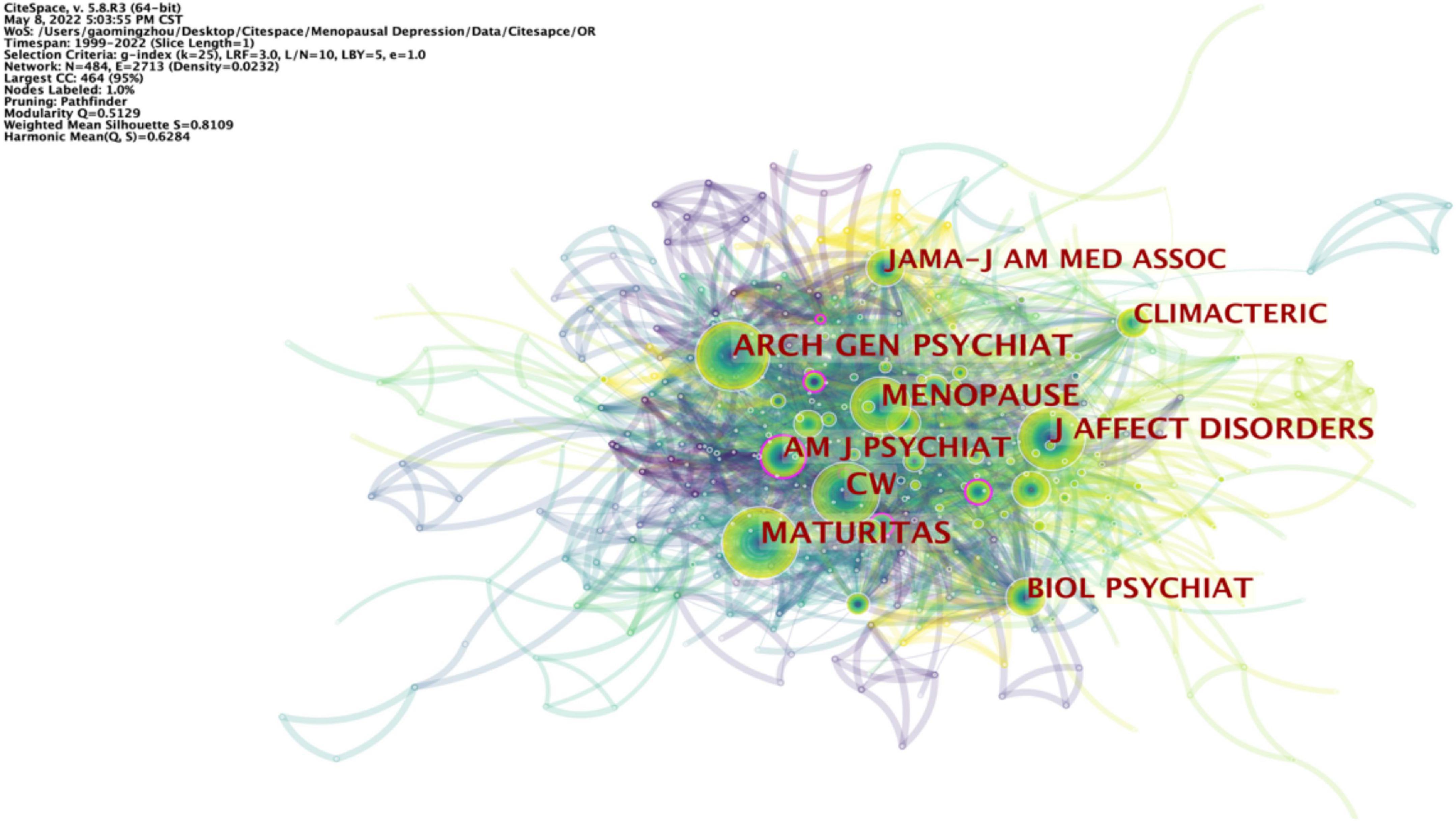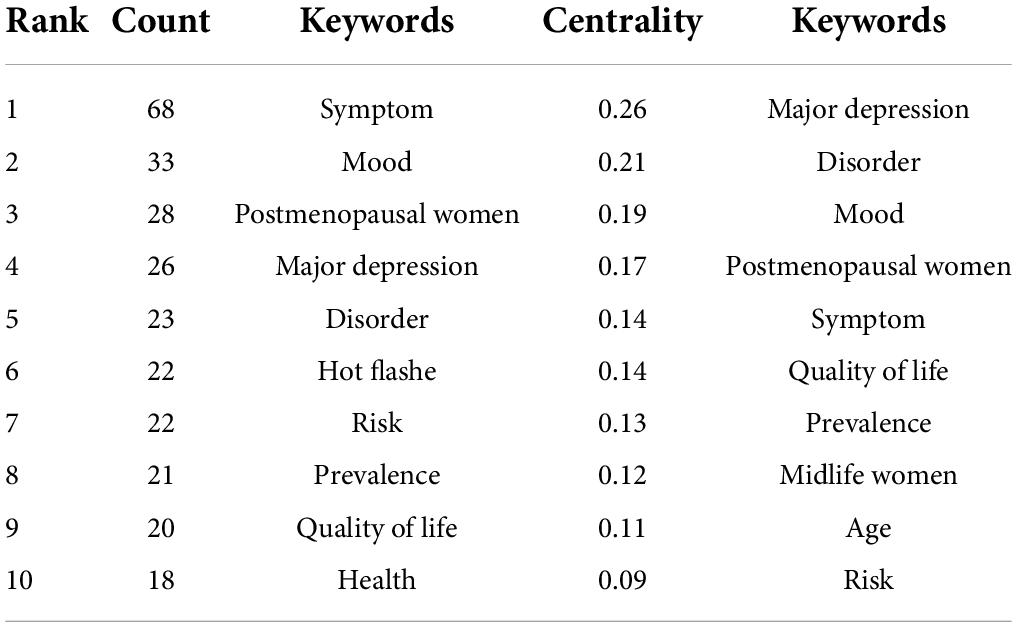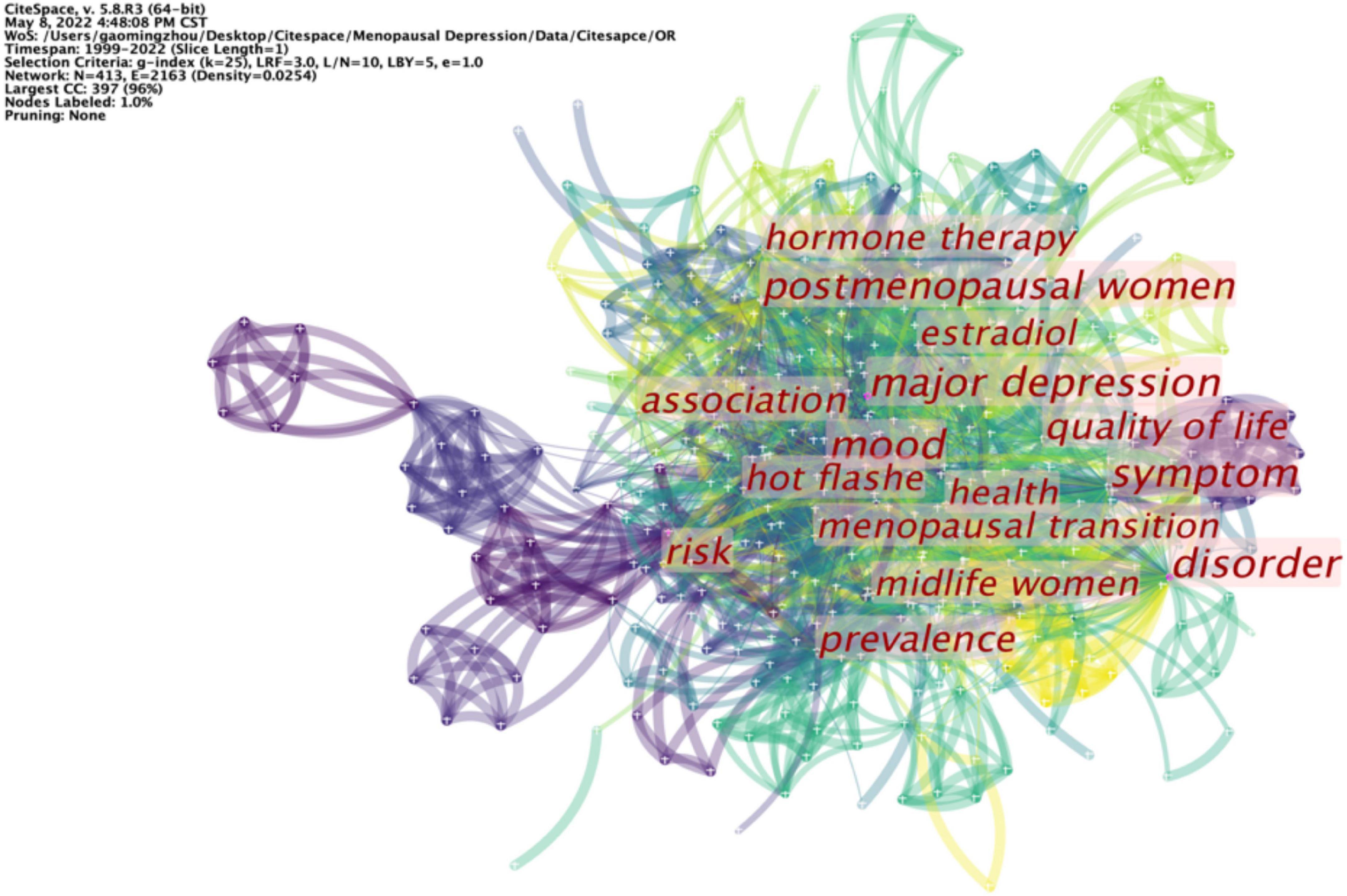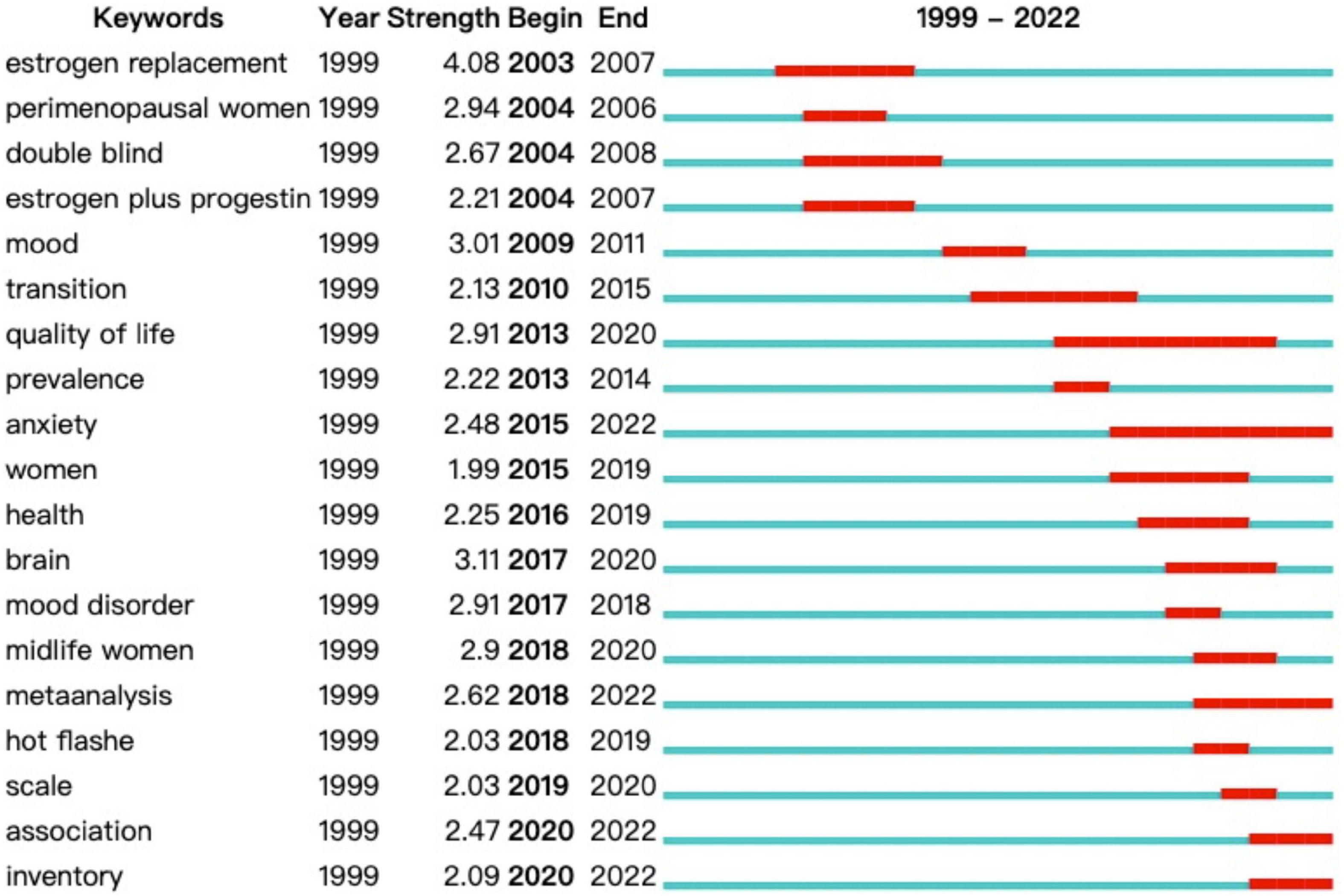- 1Innovation Research Institute of Traditional Chinese Medicine, Shandong University of Traditional Chinese Medicine, Jinan, China
- 2Experimental Center, Shandong University of Traditional Chinese Medicine, Jinan, China
- 3College of Traditional Chinese Medicine, Shandong University of Traditional Chinese Medicine, Jinan, China
- 4Office of Academic Research, Shandong University of Traditional Chinese Medicine, Jinan, China
Background: Perimenopausal depression (PMD) is characterized by affective symptoms as well as menopause-specific somatic complaints and has attracted increasing attention over the past few decades. Using a bibliometric tool, this study aims to evaluate the origin, current hotspots, and research trends on PMD.
Methods: Articles with research on PMD were retrieved from Web of Science Core Collection (WoSCC). We used the bibliometric method to analyze publication years, journals, countries, institutions, authors, research hotspots, and trends. We plotted the reference co-citation network and used keywords to analyze the research hotspots and trends.
Results: A total of 209 publications related to PMD were identified from WoSCC on May 8, 2022. The number of publications concerning PMD every year shows an upward trend. Further analysis indicated that 209 articles were contributed by 45 countries, 288 institutions, and 501 authors. The United States contributed the most significant number of publications, followed by China. Harvard University is the core institution of PMD research, and Cohen’s work has had an important impact on another research. The occurrence and pathological mechanisms of depression during the menopausal transition from the knowledge base of PMD. All of them belong to the category of gynecology and psychosis, which reflects the focus of the research topics. Major depression, postmenopausal women, symptoms like hot flashes, and prevalence and risk factors are research hotspots in the PMD field. The frontiers in PMD field that will impact future research are anxiety, meta-analysis, association, and Beck Depression Inventory-II (BDI-II).
Conclusion: These findings provide us with the core countries, institutions, and authors in PMD research and point out the direction of attention in this field. The current research focuses on depression, postmenopausal women, hot flashes, and other symptoms, as well as the prevalence and risk factors. The frontiers will be anxiety, meta-analysis, related factors, and depression assessment in future research.
Introduction
Perimenopause is a natural physiological event in women that involves premenopause, menopausal transition, and early post-menopause (1). Within the female life cycle, women demonstrate a higher prevalence of or are at risk of depressive symptoms (2–4). Published research indicates that the highest rate of depression in perimenopause was 25.99% in Shanghai, China (5), and the prevalence of depression in perimenopausal and postmenopausal women in India is 42.47% (6). Furthermore, perimenopausal depression (PMD) is one of the forms of reproductive depression in women related to hormonal changes (7, 8). Women with PMD reported significantly decreased quality of life (QOL), social support, adjustment, suicidal thoughts, and increased disability and compared with non-depressed perimenopausal women (9).
There has been growing research on depression among perimenopausal women in recent years. However, there is no bibliometric analysis via CiteSpace on global research trends and hotspots in this field. CreateSpace is scientific software that has been widely used to identify frontier areas of current research by extracting burst terms from identifiers of titles, abstracts, descriptors, and bibliographic records (10). CiteSpace’s recognition in the field of research has increased considerably in recent years. It is used widely in many research fields such as medicine, geology, and others (11–13) and has promoted the rapid development of relevant research (14).
This study aims to investigate the knowledge domain and gain insights into emerging trends and hot spots of PMD by constructing a visualization network via CiteSpace.
Methods
Data source and search strategy
Data were extracted from the Web of Science Core Collection (WoSCC) and downloaded one day on May 8, 2022. The search strategy was as follows: TITLE = (postmenopausal depression) or TITLE = (menopausal depression) or TITLE = (depression in midlife women) or TITLE = (depression) and TITLE = (“menopause” or “perimenopause”). The search was conducted from the beginning of the database collection to May 8, 2022.
Inclusion criteria and exclusion criteria
Publications related to PMD were identified from WoSCC published up to 2022 (retrieval deadline: 2022.5.8). And we excluded conference presentations, meeting abstracts, book reviews, news items, and corrections.
Data analysis
This study utilized CiteSpace V.5.8.R2 to visually analyze the knowledge map of countries, institutions, authors, journals, references, and keywords concerning relevant research (15, 16). The visualization knowledge network created by CiteSpace consisted of nodes and lines. The nodes in the network stood for items, such as authors, countries, institutions, and cited references, and lines between the nodes represented cooperation, co-occurrence, or co-citation relationships. The size of each node indicated the count. Each node was represented by a series of citation rings representing different years, and the thickness of the ring was proportional to the citation count in the corresponding time zone. Purple rings indicate that these countries/regions, institutes, or authors have greater centrality indicating hot spots or pivotal points in a field (10–17).
Results
The trend of publication outputs
A total of 379 publications related to PMD were identified, but 209 were finally included for further analysis (Figure 1). The number of publications and citations published in each period reflects the development trend of research in this field. As revealed in Figure 2, the number of publications concerning PMD has revealed an upward trend from 1999 to 2022, but the volatility is prominent. From 1999 to 2004, the steady increase in PMD research publications indicates that research in this field attracts increasing attention. In 2005, the study was at a standstill. After 2005, PMD field began to receive attention again, and the number of published articles increased considerably from 2017 to 2021, with publication outputs reaching 24 in 2022. Besides, the citation frequency of the report also shows that research in PMD field garnered incredible attention. The health problems of perimenopausal women have attracted attention.
Quantitative and cooperation analysis
Countries/regions
A total of 209 articles were published in 45 different countries. As Table 1 displays, the most significant number of publications came from the United States (79, 37.80%), China (25, 11.96%), South Korea (19, 9.09%), Turkey (13, 6.22%), and Canada (9, 4.31%), all of which published more than ten articles, except for Canada. The United States has the highest centrality (0.26), presented in Figure 3 with a purple circle. The lines between the processes denote cooperation between countries, and the wider the bars, the closer the cooperation. All of these indicate that the United States plays a leading role in the research in this field, and China still has a long way to go if it wants to catch up with this rate and even surpass it.
Institutes
A total of 209 articles were published from 288 different institutions. Among the top ten institutions, Harvard University and the University of Pittsburgh have posted the same number of articles in this field, with ten published articles each. Notably, Harvard University is also the organization with the highest centrality, with a centrality of 0.02 (Table 2). In addition, Figure 4 indicates that inter-agency cooperation is relatively close and conducive to the continuity of inter-agency cooperative research.
Authors and co-cited authors
A total of 501 authors were involved in publishing literature on PMD. As presented in Table 3, Soares had the highest number of published papers (13). Among the top 10 authors, we can observe that Cohen (0.01) has high centralities, showing that Cohen strongly influences other work (Table 3). Simultaneously, we found that 209 authors have not yet formed an extensive cooperation network, and scientific research cooperation is relatively scattered (Figure 5).
Co-cited authors are two or more authors cited by one or more papers simultaneously, and these authors constitute a co-cited relationship. Among the 612 co-cited authors, Bromberger (25) was the most frequently cited author, followed by Freeman (25) and Cohen (21) (Table 4). We noticed that Freeman and Cohen are leaders in this field, and their scientific research achievements play a guiding role in developing this field.
Research topic analysis
Reference co-citation
Among 476 co-cited references retrieved, Table 5 and Figure 6 displays the 10 most frequently cited references; “Risk for new onset of depression during the menopausal transition: the Harvard study of moods and cycles” contributed by Cohen is the most frequently cited (23). In this article, Cohen explained that the transition to menopause increases the risk of depressive symptoms, and the article aroused great interest in follow-up research. Relevant directions have become research hotspots in terms of citation frequency.
Besides, as depicted in Table 6, “Depressed mood during the menopausal transition and early post-menopause: Observations from the Seattle Midlife Women’s Health Study” contributed by Woods in 2008 has the highest centrality (0.22), which indicates that Woods’s findings have become a research hotspot.
Journal co-citation
A total of 209 related to PMD were published in 124 academic journals. Menopause: The Journal of the North American Menopause Society (21) had the highest number of outputs, followed by Maturitas (11). Among the top 10 journals related to PMD, the Journal of Affective Disorders has the highest impact factor, 4.836. The JCR division of Maturitas, the Journal of Affective Disorders, and the Journal of Clinical Psychiatry are very high, Q1 (Table 7).
Among the top 10 co-cited academic journals, five journals have been cited a hundred times more than the other 474 journals. As shown in Table 8 and Figure 7, the journals with the highest number of citations are the Archives of General Psychiatry (133), followed by Maturitas (127). Besides, the journals with the highest centrality are Am J Obstet Gynecol (0.18), followed by Acta Psychiat Scand (0.15).
The dual-map overlay of journals demonstrates the relationship distribution among journals, citing journals on the left and the right. The colored paths between them suggest the aforementioned relationships. A green path in Figure 8 indicates that documents published in molecular/biology/genetics, health/nursing/medicine, and psychology/education/social journals are often cited by medicine/medical/clinical and neurology/sports/ophthalmology journals. A green path in Figure 8 indicates that psychology/education/health journals often cite the documents published in economics/economic/political journals.
Research hotspots and frontiers analysis
Keywords co-occurrence
High-frequency keywords represent a hot topic in a research field, while high-centrality keywords reflect the position and influence of the corresponding research content in this research field. As revealed in Table 9, hot keywords in the frequency order were symptom (68), mood (33), postmenopausal women (28), major depression (26), and disorder (23). Hot keywords in the centrality order comprised major depression (0.26), disorder (0.21), mood (0.19), postmenopausal women (0.17), and symptom (0.14). Other keywords included hot flashes, risk, prevalence, quality of life, and so on (Figure 9).
Emerging trends
Figure 10 displays the top 19 keywords with the strongest citation bursts in published articles on PMD. The blue line represents the time interval, and the red line refers to the duration of the citation burst. In the keyword’s citation burst detection analysis, Estrogen replacement was the strongest burst keyword in 2003, with a burst strength of 4.08, followed by mood (3.01). Five frontiers in PMD field that will impact future research are anxiety, meta-analysis, association, and inventory.
Discussion
General information
The harm of PMD to women is gradually attracting attention. Using PMD as a keyword in this study, we searched relevant studies included in WOS until May 8, 2022, and finally included 209 studies. PMD research began in 1999, “Estrogen therapy for depression in postmenopausal women” is the work that started in this period. After 1999, PMD research gradually aroused researchers’ interest and showed an upward trend, reaching a peak in 2021. Further analysis indicated that 209 articles were contributed by 45 countries, 288 institutions, and 501 authors. Furthermore, the United States contributed the most significant number of publications, followed by China. The United States is in the core leadership position regarding the number of published articles and centrality. The significant development made by China is also full of potential for future research. As for contributing intuitions, Harvard University is the core institution of PMD research, and its research direction and findings play an important guiding role in PMD research. Besides, close scientific research cooperation has not been formed in PMD research between authors, and Cohen’s work has an important impact on another research.
Research fundamentals
The top co-cited articles are often considered fundamental and a basis for a specific research field. In this study, “Risk for new onset of depression during the menopausal transition: the Harvard study of moods and cycles” contributed by Cohen ranked first in the frequency of citation, and “Depressed mood during the menopausal transition and early post-menopause: Observations from the Seattle Midlife Women’s Health Study” contributed by Woods in 2008 ranked first in centrality. The menopause transition is a disruptive process that causes symptoms such as mood disruption in most women (18). Thus, clinicians must recognize depressive symptoms of the transition and be prepared to offer treatment to mitigate these symptoms (19). The occurrence and pathological mechanisms of depression during the menopausal transition from the knowledge base of PMD.
Research topic
The highly cited journals reflect the research topic in PMD field to a certain extent. This study found that Menopause: The Journal of the North American Menopause Society had the highest number of outputs. Besides, the Archives of General Psychiatry has the highest number of citations, and Am J Obstet Gynecol has the highest centrality. All of them belong to the category of gynecology and psychosis, which reflects the focus of the research topics. Furthermore, the dual-map overlay of journals demonstrates the relationship distribution among journals such as molecular/biology/genetics, health/nursing/medicine, psychology/education/social, etc.
Research hotspots and frontiers
Keywords are the research themes and core contents of the literature, suggesting research hotspots and frontiers in a particular field. The four research hotspots in the field of PMD are as follows:
Major depression
Depression is a common mood disorder with a wide array of symptoms affecting somatic, cognitive, affective, and social processes in adolescence, midlife, and the elderly (20–22). Among midlife women, depression is one of the leading causes of disease-related disability. They are nearly twice as likely as men to suffer from an episode of depression (22). Besides, evidence generally suggests that most midlife women who experience a major depressive episode during perimenopause have experienced a prior episode of depression. Midlife depression presents with classic depressive symptoms, commonly combined with menopause symptoms (23).
Postmenopausal women
Menopause, defined by amenorrhea for 12 consecutive months, is determined retrospectively and represents a permanent end to menses. Many physical changes occur during the menopausal transition and beyond (24). Established studies have indicated that minor depression predominates in perimenopausal women (21.4%), and major depression predominates in postmenopausal women (59.3%) (25). Besides, postmenopausal women also have an increased risk of other diseases, such as dyspareunia (26), hypertension (27), and others.
Related symptoms like hot flashes
Hot flashes (HFs) are a sensation of heat that can be accompanied by facial flushing, perspiration, chills, heart palpitations, night sweats, and anxiety (28). For women with perimenopausal syndrome, hot flashes are its characteristic manifestations (29, 30). Studies have indicated that HF disturbs sleep, causing insomnia and increasing vulnerability to depression (31–33). Besides, hot flashes are a common stressful symptom for individuals with cancer and other diseases (34). Therefore, studies in pathophysiology and treatment of hot flashes are becoming prevalent (35–37).
Prevalence and risk factors
To understand the development trends of a disease, it is essential to master its incidence rate and risk factors. For instance, the prevalence of major depression among middle-aged women was 26.09% in the rural area of Kerala (38). The highest rate of depression among perimenopausal women was 25.99% in Shanghai, China (5). Relevant studies are still being performed (6). Besides, managing the risk factors of PMD remains a hotspot for improving the health of perimenopausal women (39, 40).
The four frontiers in PMD field that will impact future research include anxiety, meta-analysis, association, and inventory.
Anxiety disorder
Anxiety is the feeling of fear that occurs when faced with threatening or stressful situations (41). About 85% of patients with depression have significant anxiety (42). Established studies reveal that anxiety increases during the menopausal transition with depressed mood (43–45). Furthermore, anti-anxiety research will become a research frontier in PMD field (46–48).
Meta-analysis
A meta-analysis is a statistical method for combining the results of different studies on the same topic. It may resolve conflicts among studies and plays a vital role in medical research (49, 50). Meta-analysis is being used in research on perimenopausal women and has made important discoveries. For instance, Yadav et al. found that depression prevalence in perimenopausal and postmenopausal women in India is 42.47% (6). By meta-analysis, long-term hormone therapy for perimenopausal and postmenopausal women is also vital for evaluating the effectiveness and safety of treatment methods (51). More meta-analyses of PMD will be conducted in the future.
Association study
Since PMD is not a single disease but is very complex, association studies are being carried out. In terms of mechanisms, perimenopause is associated with reproductive and hormonal changes (1). Thus, perimenopausal mood disorders are related to other reproductive-related conditions such as premenstrual syndrome (52, 53). Besides, research on the association between low bone mineral density and periodontitis in perimenopausal women (54), the association between homocysteine, C-reactive protein, lipid levels, and sleep quality in perimenopausal and postmenopausal women (55), and so on are frontiers in subsequent research.
Beck Depression Inventory-II application
The Beck Depression Inventory-II (BDI-II) is viewed as a cost-effective questionnaire for measuring the severity of depression and is frequently used (56–58). As a relevant psychometric instrument, BDI-II shows high reliability and can discriminate between depressed and non-depressed subjects for research and clinical practice worldwide (58, 59). Therefore, using BDI-II to measure depression in perimenopausal women is well recognized, and the tool will be widely used in the future (60).
Strengths and limitations
This is the first study to use CiteSpace to perform bibliometric analysis and provide a visual display of publications on PMD from the cooperation among authors, countries, and institutions to hot spots. However, our study still has some limitations. Since the study was limited to CiteSpace software, we analyzed only English studies in WOS; therefore, the data may be insufficient. Our results may be inapplicable to research published in other languages. Furthermore, Citespace’s analysis cannot give a direct answer for clinicians who are looking for effective interventions or researchers who are looking for novel research methods, or clinical teachers who are looking for up-to-date information about a topic. Indirectly, however, it points clinicians, teachers, and investigators to sources that can answer their questions.
Conclusion
A current study via CiteSpace suggested United States, Harvard University, and Cohen LS are the core of PMD research from countries, institutions, and authors. Major depression, postmenopausal women, symptoms like hot flashes, and prevalence and risk factors are research hotspots in PMD. Four frontiers in the area of PMD that impact research are anxiety symptoms, meta-analysis research, association and difference, and BDI-II application in the future.
Author contributions
MG designed the study, wrote, and revised the draft manuscript. MG, HZ, ZG, YS, and JW performed the literature search, retrieval, and data collection. MG conducted data visualization and graphical interpretation with HZ. DG and FW provided critical assistance and funding. All authors contributed to and approved the final draft of the manuscript before submission.
Funding
This study was supported by the Key Project of Natural Science Foundation of Shandong Province (Grant No. ZR2020ZD17), the National Natural Science Foundation of China (Grant Nos. 81001484 and 81473558), the Natural Science Foundation of Shandong Province (Grant No. ZR202102270167), the Shandong Medical and Health Science and Technology Development Plan Project (Grant No. 202105010467), and “20 Articles for Colleges and Universities” funded project in Jinan (Grant No. 2020GXRC002).
Acknowledgments
We would like to acknowledge the support of the Team of Research and Innovation Focusing on Emotional Diseases and Syndromes in Shandong University of Traditional Chinese Medicine, and the Team of Young Scientific Research and Innovation Focusing on Pharmacology Mechanism of Emotional Diseases and Syndromes in Ganzangxiang.
Conflict of interest
The authors declare that the research was conducted in the absence of any commercial or financial relationships that could be construed as a potential conflict of interest.
Publisher’s note
All claims expressed in this article are solely those of the authors and do not necessarily represent those of their affiliated organizations, or those of the publisher, the editors and the reviewers. Any product that may be evaluated in this article, or claim that may be made by its manufacturer, is not guaranteed or endorsed by the publisher.
References
2. Willi J, Ehlert U. Assessment of perimenopausal depression: A review. J Affect Disord. (2019) 249:216–22.
3. Padda J, Khalid K, Hitawala G, Batra N, Pokhriyal S, Mohan A, et al. Depression and its effect on the menstrual cycle. Cureus. (2021) 13:e16532.
4. Maki PM, Kornstein SG, Joffe H, Bromberger JT, Freeman EW, Athappilly G, et al. Guidelines for the evaluation and treatment of perimenopausal depression: Summary and recommendations. J Womens Health (Larchmt). (2019) 28:117–34.
5. Li RX, Ma M, Xiao XR, Xu Y, Chen XY, Li B. Perimenopausal syndrome and mood disorders in perimenopause: Prevalence, severity, relationships, and risk factors. Medicine (Baltimore). (2016) 95:e4466.
6. Yadav V, Jain A, Dabar D, Goel AD, Sood A, Joshi A, et al. A meta-analysis on the prevalence of depression in perimenopausal and postmenopausal women in India. Asian J Psychiatr. (2021) 57:102581. doi: 10.1016/j.ajp.2021.102581
9. Wariso BA, Guerrieri GM, Thompson K, Koziol DE, Haq N, Martinez PE, et al. Depression during the menopause transition: Impact on quality of life, social adjustment, and disability. Arch Womens Ment Health. (2017) 20:273–82. doi: 10.1007/s00737-016-0701-x
10. Synnestvedt MB, Chen C, Holmes JH. CiteSpace II: Visualization and knowledge discovery in bibliographic databases. AMIA Annu Symp Proc. (2005) 2005:724–8.
11. Yao L, Hui L, Yang Z, Chen X, Xiao A. Freshwater microplastics pollution: Detecting and visualizing emerging trends based on citespace II. Chemosphere. (2020) 245:125627. doi: 10.1016/j.chemosphere.2019.125627
12. Zhan J, Ma Y, Zhao D, Li Z, Tan H, Wang X, et al. Knowledge atlas of post-traumatic epilepsy research: Based on citespace visualization analysis. Epilepsy Res. (2021) 178:106790. doi: 10.1016/j.eplepsyres.2021.106790
13. Xie XP, Pan ZJ, Wang K, Yu YX, Liang M. CiteSpace-based document information visualization of literature published by journal of forensic medicine from 1985 to 2018. Fa Yi Xue Za Zhi. (2019) 35:423–7. doi: 10.12116/j.issn.1004-5619.2019.04.008
14. Chen C, Song M. Visualizing a field of research: A methodology of systematic scientometric reviews. PLoS One. (2019) 14:e0223994. doi: 10.1371/journal.pone.022399
15. Wu MQ, Wu DQ, Hu CP, Iao LS. Studies on children with developmental coordination disorder in the past 20 years: A bibliometric analysis via citespace. Front Psychiatry. (2021) 12:776883. doi: 10.3389/fpsyt.2021.776883
16. Ma D, Yang B, Guan B, Song L, Liu Q, Fan Y, et al. A bibliometric analysis of pyroptosis from 2001 to 2021. Front Immunol. (2021) 12:731933. doi: 10.3389/fimmu.2021.731933
17. Shi YM, Luo JM, Wang XQ, Zhang YQ, Zhu H, Su DS, et al. Emerging trends on the correlation between neurotransmitters and tumor progression in the last 20 years: A bibliometric analysis via citespace. Front Oncol. (2022) 12:800499. doi: 10.3389/fonc.2022.800499
18. Talaulikar V. Menopause transition: Physiology and symptoms. Best Pract Res Clin Obstet Gynaecol. (2022) 81:3–7.
19. Santoro N, Roeca C, Peters BA, Neal-Perry G. The menopause transition: Signs, symptoms, and management options. J Clin Endocrinol Metab. (2021) 106:1–15.
20. Kieling C, Adewuya A, Fisher HL, Karmacharya R, Kohrt BA, Swartz JR, et al. Identifying depression early in adolescence. Lancet Child Adolesc Health. (2019) 3:211–3.
21. Wang X, Guo J, Liu H, Zhao T, Li H, Wang T. Impact of social participation types on depression in the elderly in china: An analysis based on counterfactual causal inference. Front Public Health. (2022) 10:792765. doi: 10.3389/fpubh.2022.792765
23. Maki PM, Kornstein SG, Joffe H, Bromberger JT, Freeman EW, Athappilly G, et al. Guidelines for the evaluation and treatment of perimenopausal depression: Summary and recommendations. Menopause. (2018) 25:1069–85.
25. Carranza-Lira S, Palacios-Ramirez M. Depression frequency in premenopausal and postmenopausal women. Rev Med Inst Mex Seguro Soc. (2019) 56:533–6.
26. Kao A, Binik YM, Kapuscinski A, Khalife S. Dyspareunia in postmenopausal women: A critical review. Pain Res Manag. (2008) 13:243–54.
27. Leuzzi C, Modena MG. Hypertension in postmenopausal women: Pathophysiology and treatment. High Blood Press Cardiovasc Prev. (2011) 18:13–8.
29. Cao Z, Tang J, Xue Y, Wang Q, Li S, Zhou Y, et al. [Comparison between manual acupuncture and electroacupuncture for hot flashes and sex hormone of perimenopausal syndrome]. Zhongguo Zhen Jiu. (2017) 37:247–52. doi: 10.13703/j.0255-2930.2017.03.007
30. Wu XL, Sun JH, Sheng Y, Yuan MQ, Miao D, Song YF, et al. [Professor SHENG Can-ruo’s academic thoughts and acupoint selection experience for hot flashes]. Zhongguo Zhen Jiu. (2019) 39:989–91. doi: 10.13703/j.0255-2930.2019.09.020
31. Freedman RR. Menopausal hot flashes: Mechanisms, endocrinology, treatment. J Steroid Biochem Mol Biol. (2014) 142:115–20.
32. Bonanni E, Schirru A, Di Perri MC, Bonuccelli U, Maestri M. Insomnia and hot flashes. Maturitas. (2019) 126:51–4.
34. Fisher WI, Johnson AK, Elkins GR, Otte JL, Burns DS, Yu M, et al. Risk factors, pathophysiology, and treatment of hot flashes in cancer. CA Cancer J Clin. (2013) 63:167–92.
35. Morrow PK, Mattair DN, Hortobagyi GN. Hot flashes: A review of pathophysiology and treatment modalities. Oncologist. (2011) 16:1658–64.
36. Tsoumani M, Nikolaou PE, Argyropoulou A, Tseti I, Mitakou S, Andreadou I. Novel evidence-based combination of plant extracts with multitarget mechanisms of action for the elimination of hot flashes during menopause. Molecules. (2022) 27:1221. doi: 10.3390/molecules27041221
37. Miyazaki K, Kaneko M, Narukawa M. Factors associated with high placebo response in clinical studies of hot flashes: A meta-analysis. Menopause. (2021) 29:239–46. doi: 10.1097/GME.0000000000001895
38. Ps A, Das S, Philip S, Philip RR, Joseph J, Punnoose VP, et al. Prevalence of depression among middle aged women in the rural area of Kerala. Asian J Psychiatr. (2017) 29:154–9. doi: 10.1016/j.ajp.2017.05.016
40. Kim C. Management of cardiovascular risk in perimenopausal women with diabetes. Diabetes Metab J. (2021) 45:492–501.
43. Wang D, Wang X, Luo MT, Wang H, Li YH. Gamma-aminobutyric acid levels in the anterior cingulate cortex of perimenopausal women with depression: A magnetic resonance spectroscopy study. Front Neurosci. (2019) 13:785. doi: 10.3389/fnins.2019.00785
44. Bryant C, Judd FK, Hickey M. Anxiety during the menopausal transition: A systematic review. J Affect Disord. (2012) 139:141–8.
46. Aibar-Almazán A, Hita-Contreras F, Cruz-Díaz D, de la Torre-Cruz M, Jiménez-García JD, Martínez-Amat A. Effects of pilates training on sleep quality, anxiety, depression and fatigue in postmenopausal women: A randomized controlled trial.. Maturitas. (2019) 124:62–7.
47. Cagnacci A, Xholli A, Fontanesi F, Neri I, Facchinetti F, Palma F. Treatment of menopausal symptoms: Concomitant modification of cortisol. Menopause. (2021) 29:23–7. doi: 10.1097/GME.0000000000001875
50. Schwarzer G, Rucker G. Meta-analysis of proportions. Methods Mol Biol. (2022) 2345:159–72. doi: 10.1016/j.parepi.2022.e00254
51. Marjoribanks J, Farquhar C, Roberts H, Lethaby A, Lee J. Long-term hormone therapy for perimenopausal and postmenopausal women. Cochrane Database Syst Rev. (2017) 1:Cd004143.
52. Feld J, Halbreich U, Karkun S. The association of perimenopausal mood disorders with other reproductive-related disorders. CNS Spectr. (2005) 10:461–70.
53. Chung SH, Kim TH, Lee HH, Lee A, Jeon DS, Park J, et al. Premenstrual syndrome and premenstrual dysphoric disorder in perimenopausal women. J Menopausal Med. (2014) 20:69–74.
54. Gil-Montoya JA, Garrido-Martínez M, Barrios-Rodríguez R, Ramos-García P, Lenouvel D, Montes-Castillo C, et al. Association between low bone mineral density and periodontitis in generally healthy perimenopausal women. J Periodontol. (2021) 92:95–103. doi: 10.1002/JPER.20-0029
55. Zhang H, Wang Q, Deng M, Chen Y, Liu W, Huang J, et al. Association between homocysteine, C-reactive protein, lipid level, and sleep quality in perimenopausal and postmenopausal women. Medicine (Baltimore). (2021) 100:e28408. doi: 10.1097/MD.0000000000028408
56. Fooladi E, Bell RJ, Masoumi M, Azizi M, Atarod Z, Davis SR. Bothersome menopausal symptoms amongst postmenopausal Iranian women. Climacteric. (2018) 21:586–93. doi: 10.1080/13697137.2018.1493452
57. Smarr KL, Keefer AL. Measures of depression and depressive symptoms: Beck depression inventory-II (BDI-II), center for epidemiologic studies depression scale (CES-D), geriatric depression scale (GDS), Hospital anxiety and depression scale (HADS), and patient health questionnaire-9 (PHQ-9). Arthritis Care Res (Hoboken). (2011) 63(Suppl. 11):S454–66. doi: 10.1002/acr.20556
58. Wang YP, Gorenstein C. Psychometric properties of the Beck depression inventory-II: A comprehensive review. Braz J Psychiatry. (2013) 35:416–31.
59. Garcia-Batista ZE, Guerra-Pena K, Cano-Vindel A, Herrera-Martinez SX, Medrano LA. Validity and reliability of the Beck depression inventory (BDI-II) in general and hospital population of dominican republic. PLoS One. (2018) 13:e0199750. doi: 10.1371/journal.pone.0199750
60. Khoshbooii R, Hassan SA, Deylami N, Muhamad R, Engku Kamarudin EM, Alareqe NA. Effects of group and individual culturally adapted cognitive behavioral therapy on depression and sexual satisfaction among perimenopausal women. Int J Environ Res Public Health. (2021) 18:7711. doi: 10.3390/ijerph18147711
Keywords: perimenopausal depression, web of science, trends, knowledge domain, CiteSpace front psychiatry
Citation: Gao M, Zhang H, Gao Z, Sun Y, Wang J, Wei F and Gao D (2022) Global hotspots and prospects of perimenopausal depression: A bibliometric analysis via CiteSpace. Front. Psychiatry 13:968629. doi: 10.3389/fpsyt.2022.968629
Received: 14 June 2022; Accepted: 14 July 2022;
Published: 10 September 2022.
Edited by:
Gaia Romana Pellicano, Sapienza University of Rome, ItalyReviewed by:
Mary V. Seeman, University of Toronto, CanadaChiara Ciacchella, Sapienza University of Rome, Italy
Copyright © 2022 Gao, Zhang, Gao, Sun, Wang, Wei and Gao. This is an open-access article distributed under the terms of the Creative Commons Attribution License (CC BY). The use, distribution or reproduction in other forums is permitted, provided the original author(s) and the copyright owner(s) are credited and that the original publication in this journal is cited, in accordance with accepted academic practice. No use, distribution or reproduction is permitted which does not comply with these terms.
*Correspondence: Dongmei Gao, Z2N5XzExMkAxNjMuY29t
†These authors have contributed equally to this work and share first authorship
 Mingzhou Gao
Mingzhou Gao Hao Zhang2†
Hao Zhang2†